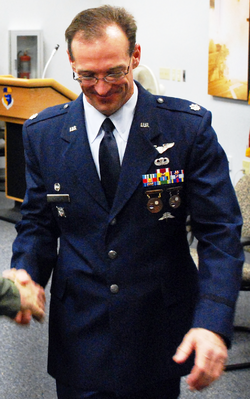

Badges of the United States Air Force are specific uniform insignia authorized by the United States Air Force that signify aeronautical ratings, special skills, career field qualifications, and serve as identification devices for personnel occupying certain assignments. [1]
Contents
- Aviation Badges
- Aeronautical Rating Badges
- Aircrew Badges
- Occupational Badges
- Operations Career Group
- Logistics Career Group
- Support Career Group
- Professional Career Group
- Acquisition Career Group
- Medical Career Group
- Reporting Identifiers
- Miscellaneous Badges
- Duty Badges
- Tabs
- Award Badges
- Air National Guard Badges and Tabs
- See also
- Notes
- References
Most Air Force badges are awarded in three degrees or skill levels. Aeronautical rating badges for pilots, combat systems officers, observers, and air battle managers are awarded at basic, senior, and command levels; while flight nurses and flight surgeons are awarded ratings at the basic, senior, and chief levels. All other aviation badges are awarded at the basic, senior, and master levels. Air Force occupational badges are normally issued in basic, senior, and master level for officers. A star and wreath system, worn above the Air Force badge, denotes which degree or skill level a service member currently holds. Previously, enlisted wear the basic badge after completing technical school, the senior badge after award of the 7-skill level, and the master badge as a master sergeant or above with 5 years in the specialty from award of the 7-skill level. For non-rated commissioned officers, the basic badge is awarded after completion of technical training, the senior badge after 7-years in their respective AFSC, and master at 15-years. Now most career field CFETPs denote the requirements for awarding each level. [1]
Chaplain, aeronautical, space, cyberspace, and missile operations badges, along with the Air Force Commander's Insignia are mandatory for wear on Air Force uniforms. With the most recent changes to Air Force uniform regulations, restrictions have been lifted on the wear of other service's skill badges that airman have earned. Precedence of badges within the same category depends on the airman's current assignment. [1] [2]
The Air Force is the most restrictive service with regard to which Air Force badges may be worn on the uniforms by other branches of the US Armed Forces. Most badges issued exclusively by the Air Force may only be displayed on Air Force uniforms. The exception to this rule is the Space Operations Badge. [1] [3]
The Air Force previously authorized continued use of a number of aviation badges originally issued by the U.S. Army during World War II. Such badges are no longer authorized and are now categorized as obsolete badges.














































































